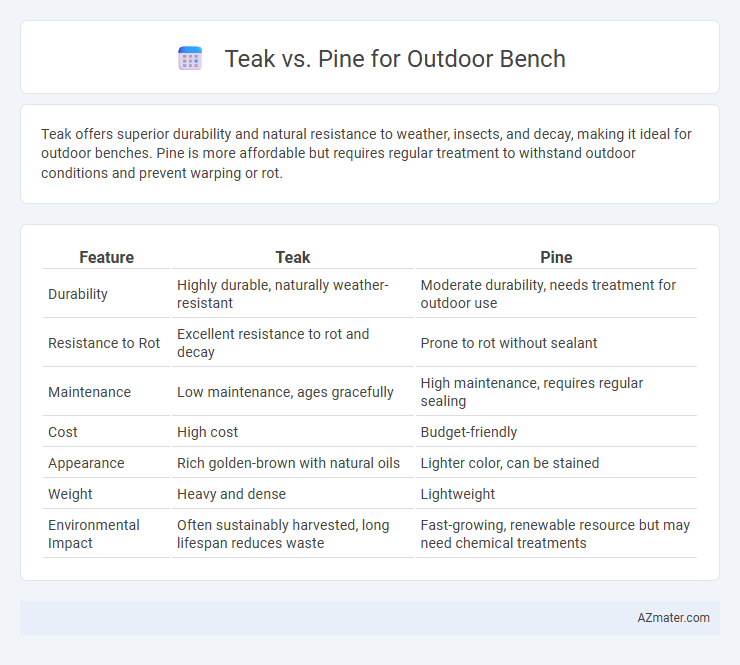Teak offers superior durability and natural resistance to weather, insects, and decay, making it ideal for outdoor benches. Pine is more affordable but requires regular treatment to withstand outdoor conditions and prevent warping or rot.
Table of Comparison
| Feature | Teak | Pine |
|---|---|---|
| Durability | Highly durable, naturally weather-resistant | Moderate durability, needs treatment for outdoor use |
| Resistance to Rot | Excellent resistance to rot and decay | Prone to rot without sealant |
| Maintenance | Low maintenance, ages gracefully | High maintenance, requires regular sealing |
| Cost | High cost | Budget-friendly |
| Appearance | Rich golden-brown with natural oils | Lighter color, can be stained |
| Weight | Heavy and dense | Lightweight |
| Environmental Impact | Often sustainably harvested, long lifespan reduces waste | Fast-growing, renewable resource but may need chemical treatments |
Introduction to Teak and Pine for Outdoor Benches
Teak and pine are popular wood choices for outdoor benches due to their unique properties and durability. Teak wood is highly valued for its natural oils and dense grain, which provide excellent resistance to weather, decay, and insects. Pine offers a more affordable option with a lighter weight and softer texture, but it requires protective treatments to withstand outdoor conditions effectively.
Durability Comparison: Teak vs Pine
Teak offers superior durability for outdoor benches due to its natural oils that resist water, decay, and insect damage, making it ideal for long-term exposure to harsh weather. Pine, while more affordable, requires regular treatment and sealing to withstand moisture and prevent rotting, significantly reducing its lifespan in outdoor settings. The density and inherent resistance of teak wood ensure a sturdier, low-maintenance bench compared to the softer, more porous pine wood prone to wear.
Weather Resistance: Which Wood Performs Better Outdoors?
Teak wood exhibits superior weather resistance compared to pine, thanks to its dense grain and natural oils that repel water and resist decay, making it ideal for outdoor benches exposed to harsh weather. Pine is more susceptible to moisture, warping, and insect damage unless it is pressure-treated or sealed regularly to enhance durability. For long-lasting outdoor furniture, teak's ability to withstand rain, sun, and temperature fluctuations ensures better performance and lower maintenance than pine.
Maintenance Requirements for Teak and Pine Benches
Teak outdoor benches require minimal maintenance due to their natural oils and dense grain, which resist water, insects, and decay, allowing them to maintain durability and appearance with occasional cleaning and light oiling. Pine benches need more frequent upkeep, including regular sealing or painting to prevent moisture damage, rot, and insect infestation, especially when exposed to varying weather conditions. Proper maintenance of both woods extends their lifespan, but teak's inherent resistance makes it a low-maintenance choice ideal for outdoor furniture.
Cost Analysis: Teak vs Pine Outdoor Benches
Teak outdoor benches typically range from $300 to $600 due to their durability and natural resistance to weather, making them a long-term investment despite the higher upfront cost. Pine benches are more budget-friendly, usually priced between $100 and $250, but require regular maintenance and treatments to withstand the elements, potentially increasing overall expenses. Considering lifecycle costs, teak offers superior value with minimal upkeep, while pine may incur added costs for preservation and replacement over time.
Aesthetic Differences: Color, Grain, and Aging
Teak wood showcases a rich golden-brown hue with a tight, straight grain pattern that deepens to a silvery-gray patina over time, enhancing outdoor bench aesthetics. Pine displays a lighter, pale yellow tone with prominent knots and a more varied grain, which tends to weather unevenly to a silvery-white shade. The natural oils in teak contribute to a smoother texture and superior color retention, whereas pine requires regular sealing to maintain its appearance and resist discoloration.
Environmental Impact: Sustainability of Teak and Pine
Teak is highly regarded for its sustainability due to its slow growth and durable hardwood properties, often sourced from responsibly managed plantations that promote forest regeneration. Pine, a fast-growing softwood, offers a renewable option with shorter harvest cycles, but its lower natural resistance to weather requires chemical treatments that can impact the environment. Choosing FSC-certified teak or pine ensures environmentally responsible forestry practices, reducing deforestation and promoting biodiversity conservation.
Weight and Workability for DIY Projects
Teak wood, known for its dense grain and natural oils, is heavier and more durable than pine, making it ideal for long-lasting outdoor benches that withstand weather conditions. Pine, being lighter and softer, offers easier workability for DIY projects, allowing for quicker cutting, shaping, and assembly, although it requires regular maintenance to prevent decay. Choosing between teak and pine depends on balancing the weight for stability versus the ease of handling during construction.
Comfort and Practicality in Outdoor Settings
Teak offers superior comfort and practicality for outdoor benches due to its natural oils that resist moisture, decay, and insects, ensuring long-lasting durability in various weather conditions. Pine benches require regular sealing and maintenance to prevent warping and rotting, making them less practical for prolonged outdoor use. The dense grain of teak provides a smooth, splinter-free surface ideal for comfortable seating, whereas pine's softer texture may degrade faster and cause discomfort over time.
Final Recommendations: Choosing the Best Wood for Your Outdoor Bench
Teak offers exceptional durability and natural resistance to moisture, insects, and decay, making it the ideal choice for a long-lasting outdoor bench. Pine is more affordable and lightweight but requires regular sealing and maintenance to withstand outdoor conditions. For those seeking a low-maintenance, weather-resistant option, teak is the best investment, while pine suits budget-conscious users willing to perform routine upkeep.

Infographic: Teak vs Pine for Outdoor Bench
 azmater.com
azmater.com